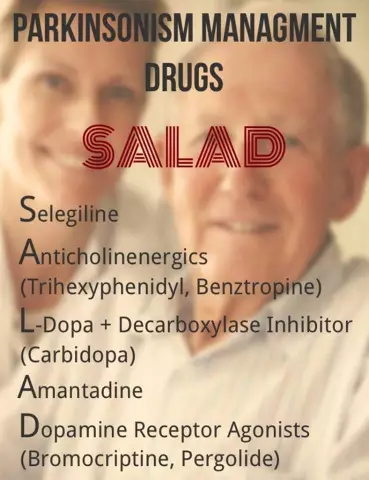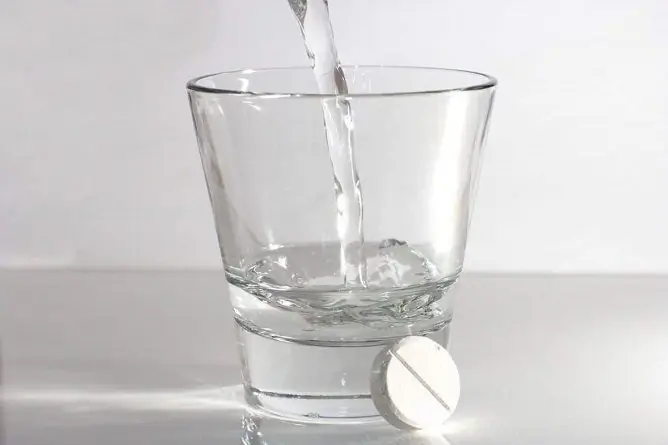- Author Rachel Wainwright [email protected].
- Public 2024-01-15 19:51.
- Last modified 2025-11-02 20:14.
Female hormones in tablets for menopause
The content of the article:
- Classification and list of drugs
-
Monotherapy with estrogen
- Proginova
- Ovestin
-
Cyclic therapy drugs
- Femoston
- Klimonorm
- Divina
- Cyclo-Proginova
- Trisequencing
- Klymene
-
Continuous therapy drugs
- Kliogest
- Premella
- How hormone replacement therapy works
-
Do I need to take hormones with menopause
- Benefits
- disadvantages
- Precautions
- Video
Menopause is a natural period in a woman's life, during which the extinction of reproductive function occurs. Its onset is associated with many unpleasant phenomena - wilting of the skin, hot flashes, vaginal dryness, and sometimes urinary incontinence. With menopause, female hormones in tablets can get rid of unpleasant symptoms. In addition, this treatment protects the heart, blood vessels, bones. However, there are also disadvantages that you should definitely familiarize yourself with. Before starting the appointment, it is recommended to weigh the pros and cons, as well as consult with a gynecologist.

To drink hormones in pills with menopause or not to drink? Before making a decision, you should consult your doctor.
Classification and list of drugs
Hormone replacement therapy (HRT) can be systemic and local. Local therapy is indicated for the treatment of urogenital disorders and does not affect the general condition of the body. Systemic therapy consists of taking hormonal pills.
There are several groups of hormonal drugs. A wide assortment creates certain difficulties when choosing them. The choice depends on many factors - the woman's age, the duration of menopause, concomitant diseases.
The table shows groups of hormonal drugs with a short description and a list of medicines.
|
Group of drugs |
Basic indications | Tablet names | |
| Preparations containing only estrogens |
Estrogen monotherapy is only prescribed for women who have had their uterus removed. With a preserved uterus, combined drugs (estrogens and progesterone) are used. |
Pretarin, Proginova, Estrofem, Ovestin | |
| Preparations containing estrogens and gestagens | Monophasic | Appointed in postmenopausal women (not earlier than 1 year after the cessation of menstruation). | Cliogest, Premella |
| Biphasic | Prescribed in the early period of menopause, when the woman agrees to keep menstruation. | Femoston, Klimonorm, Divina, Divitren, Cyclo-Proginova | |
| Three-phase | Prescribed in the early period of menopause, when the woman agrees to keep menstruation. | Trisequencing | |
| With additional antiandrogenic activity | They are prescribed for women with symptoms of hyperandrogenism - excessive hair growth, oily skin. | Klymene | |
Monotherapy with estrogen
Monotherapy with estrogens is rarely prescribed, only after surgical removal of the uterus with appendages. With a preserved uterus, the use of estrogens without gestagens is associated with an extremely high risk of endometrial cancer. The following estrogenic drugs are used in the form of tablets: Pretarin, Proginova, Estrofem, Ovestin.

Proginova - a preparation containing estradiol
Proginova
The drug contains only one component - estradiol valerate in an amount of 2 mg. Proginov is produced in the form of pills, 21 pieces in a blister. The drug replaces endogenous estrogen, which is produced by the ovaries. Promotes timely endometrial rejection and regular menstrual bleeding, in high concentrations Proginova causes endometrial hyperplasia.
Side effects may occur during treatment:
- nausea;
- vomiting;
- pathological effect on liver cells.
Take the drug inside for 21 days, 1 tablet, then take a break for 7 days. The course of treatment is 3-6 months.
Ovestin
Ovestin tablets contain estriol - 1 mg or 2 mg, which belongs to short-acting hormones.
Pills are taken by mouth, daily. The starting dosage is 4 mg (2 or 4 tablets). After 2-3 weeks, the dosage is reduced to 1-2 mg. The duration of the course of therapy is determined individually.
Cyclic therapy drugs
Cyclic drugs are used in women before menopause or in the early period. No more than 1 year should pass after the last menstrual period. This group of drugs is recommended at the beginning of replacement therapy for women under 50. When using drugs for cyclic therapy, menstrual bleeding persists in women. The medicines in this group include Femoston, Klimonorm, Divina, Divitren, Cyclo-Proginova, Trissekvens, Klimen.

Femoston is a combined hormonal drug
Femoston
Femoston 2/10 contains pink and light yellow tablets. The pink tablets contain 2 mg of estradiol, the light yellow tablets contain 2 mg of estradiol and 10 mg of dydrogesterone. Low-dose drugs include Femoston 1/10, which contains 1 mg of estradiol (white tablets), 1 mg of estradiol and 10 mg of dydrogesterone (gray).
How to take Femoston:
- In the first 14 days - one pink or white tablet per day.
- In the next 14 days - one light yellow or gray tablet per day.
- For women who have not stopped menstruating, treatment should be started on the first day after the onset of menstruation.
- For postmenopausal women, therapy can be started any day.
When taking Femoston, menstrual bleeding resumes.
Klimonorm
In the package of the drug Klimonorm there are yellow and brown pills. The yellow dragees contain 2 mg of estradiol valerate, the brown dragees contain 2 mg of estradiol valerate and 150 μg of levonorgestrel.
How to take Climonorm pills:
- In the first 9 days - one yellow tablet a day.
- In the next 12 days - one brown dragee per day.
- Then you need to take a break for 7 days. During this period, menstrual bleeding begins.
- For women who have not stopped menstruating, treatment should be started 5 days after the onset of menstruation.
- In postmenopausal women, therapy can be started any day.
Divina
Divin's packaging contains white and blue tablets. The white tablets contain 2 mg of estradiol valerate, the blue tablets contain 2 mg of estradiol valerate and 10 mg of medroxyprogesterone acetate.
How to take Divina:
- In the first 11 days - one white tablet per day.
- In the next 10 days - one blue tablet.
- This is followed by a break for 7 days. During this period, menstrual bleeding begins.
- The drug is recommended to be taken in the evening.
- If menstruation does not stop, treatment should be started 5 days after the start of menstruation. Otherwise, therapy can be started any day.
Cyclo-Proginova
The drug is available in the form of pills. The package contains 2 types of pills:
- white dragees - contain 2 mg of estradiol valerate;
- light brown dragees - contain 2 mg of estradiol valerate, 500 mcg of norgestrel.
The disadvantage of norgestrel (the progesterone component) is its lack of metabolic neutrality. With prolonged use of Cyclo-Proginov, it can reduce glucose tolerance, therefore, the drug is not recommended for women with diabetes or metabolic syndrome.
How to take Cyclo-Proginova:
- During the first 11 days, you need to take 1 white dragee.
- Over the next 10 days - 1 light brown tablet daily.
- This is followed by a break of 7 days, during which menstrual bleeding begins.
- If a woman's periods are still continuing, treatment begins on the 5th day from the onset of menstruation.
Trisequencing
Trisequencing refers to three-phase combined drugs, which include estrogens and gestagens.
There are 3 types of tablets in the Trisequens package:
- 12 pcs. blue - estradiol 2 mg;
- 10 pieces. white - estradiol 2 mg and norgestrel acetate 1 mg;
- 6 pcs. red - estradiol 1 mg.
Trisequencing is intended for hormone replacement therapy in young women (35-40 years old), when the persistence of menstrual bleeding does not bother the patients. Trisequencing is prescribed in perimenopause or early menopause.
Klymene
Klymen is a drug for cyclic hormone therapy, which has antiandrogenic activity.
The package contains 2 types of pills:
- white - contain 2 mg of estradiol valerate;
- pink - contain 2 mg of estradiol valerate and 1 mg of cyproterone acetate.
Klymen is recommended for women who have a sign of hyperandrogenism:
- excessive hair growth;
- oily skin and rashes;
- lowering the timbre of the voice.
The drug has a significant drawback - it can change glucose tolerance. Long-term use is not recommended for patients with diabetes mellitus.
Continuous therapy drugs
Medications for acyclic therapy are prescribed for postmenopausal women when more than a year has passed since the last menstrual period. The medicines of this group include Kliogest, Premella.

Kliogest is a hormonal drug for continuous therapy
Kliogest
Kliogest contains 2 medicinal substances:
- 2 mg estradiol;
- 1 mg norethisterone acetate.
Estradiol is an analogue of natural estrogen, norethisterone acetate is a synthetic progesterone. Estradiol eliminates estrogen deficiency in a woman's body, and norethisterone acetate is necessary to prevent the development of endometrial hyperplasia or cancer.
The advantage of this medication is the absence of breakthrough bleeding. Cliogest should be used daily, without interruption. The daily dose is 1 tablet.
Premella
Premella tablets contain 2 medicinal substances:
- 625 μg of conjugated estrogens;
- 2.5 mg medroxyprogesterone acetate.
Premella compensates for the deficiency of endogenous hormones. When taking the pills, menstrual bleeding does not persist. You need to use the drug 1 tablet a day daily. Not recommended for use in women over 65.
How hormone replacement therapy works
During menopause, estrogen production decreases. Deficiency of estrogen affects not only the genitals, but the entire body as a whole. The intake of female sex hormones in menopause is substitutional, that is, those hormones that are lacking in the body are introduced.
How estrogen works (endogenous or pill):
| Target organ | Act |
| Uterus | Stimulates endometrial proliferation |
| Bones | Strengthens bones by reducing bone resorption |
| Heart and blood vessels | Improves the state of the vascular endothelium, the strength of heart contractions. Influences fat metabolism - reduces the likelihood of lipid deposition on the vascular wall |
| Brain | Improves cognitive ability, regulates mood |
| Leather | Reduces the work of the sebaceous glands, which prevents excessive oily skin |
Do I need to take hormones with menopause
Whether or not to use hormone replacement therapy is a difficult choice for a woman. Treatment with female hormones has many advantages - preserving youth, getting rid of unpleasant symptoms of menopause, protecting the cardiovascular system and bone tissue. At the same time, taking hormones is associated with an increased risk of thrombosis, breast and endometrial cancer.
Benefits
Hormone replacement therapy eliminates estrogen deficiency, which has a beneficial effect on the condition of the female body. This provides the following benefits:
| Advantage | Explanation |
| Elimination of early symptoms of menopause - vasomotor and psychoemotional | Treatment with female hormones helps to get rid of hot flashes, excessive sweating, fluctuations in blood pressure, irritability, tearfulness. |
| Prevention of urogenital disorders | The organs of the urogenital tract are extremely sensitive to the level of estrogen - the vagina, urethra, and bladder. During menopause, this leads to vaginal dryness, urinary incontinence, and prolapse of the uterus. Hormone replacement therapy can stop these manifestations. Symptoms diminish by the end of 1 month, disappear completely in about 4-5 months. |
| Prevention of osteoporosis and bone fractures | During menopause, bone density decreases and their fragility increases. Treatment with estrogen can help slow bone loss. |
| Prevention of cardiovascular diseases | Estrogens have cardioprotective effects. When taken during menopause, the likelihood of developing myocardial infarction or stroke is reduced several times. |
disadvantages
There are also disadvantages to hormone replacement therapy. They are mainly associated with an increased risk of malignant neoplasms and thrombosis when taking estrogens:
- Taking estrogens promotes hypercoagulability - increased blood clotting. In this regard, HRT increases the risk of blood clots.
- Estrogens cause proliferative changes in the endometrium. This increases the risk of developing uterine cancer.
- Estrogen-dependent tumors include breast neoplasms. The risk of developing such a pathology increases when taking female hormones.
The relative disadvantages of HRT include the fact that hormonal drugs must be taken for a long time - from 5 years.
Precautions
Before prescribing HRT, a woman needs to undergo some tests. The survey includes the following methods:
- Coagulogram - performed to assess blood clotting.
- A biochemical blood test (hepatic complex) - to assess liver function.
- Ultrasound of the pelvic organs - to exclude neoplasms in the ovaries and uterus.
- Ultrasound of the mammary glands, mammography - to exclude breast tumors.
Changes in these analyzes that differ from the norm are a contraindication to the appointment of HRT.
Additionally, the level of female hormones in the blood can be studied - to assess the hormonal background.
Video
We offer for viewing a video on the topic of the article.

Anna Kozlova Medical journalist About the author
Education: Rostov State Medical University, specialty "General Medicine".
Found a mistake in the text? Select it and press Ctrl + Enter.






